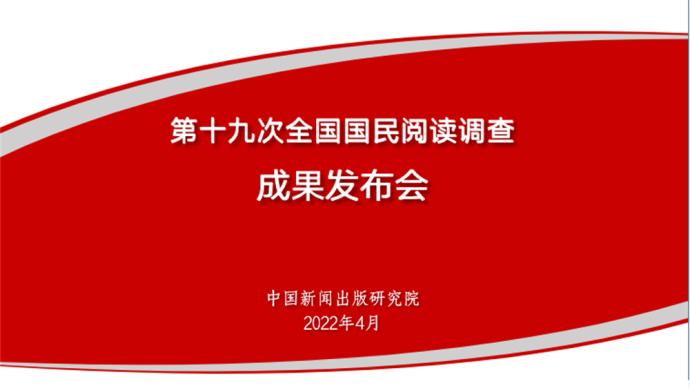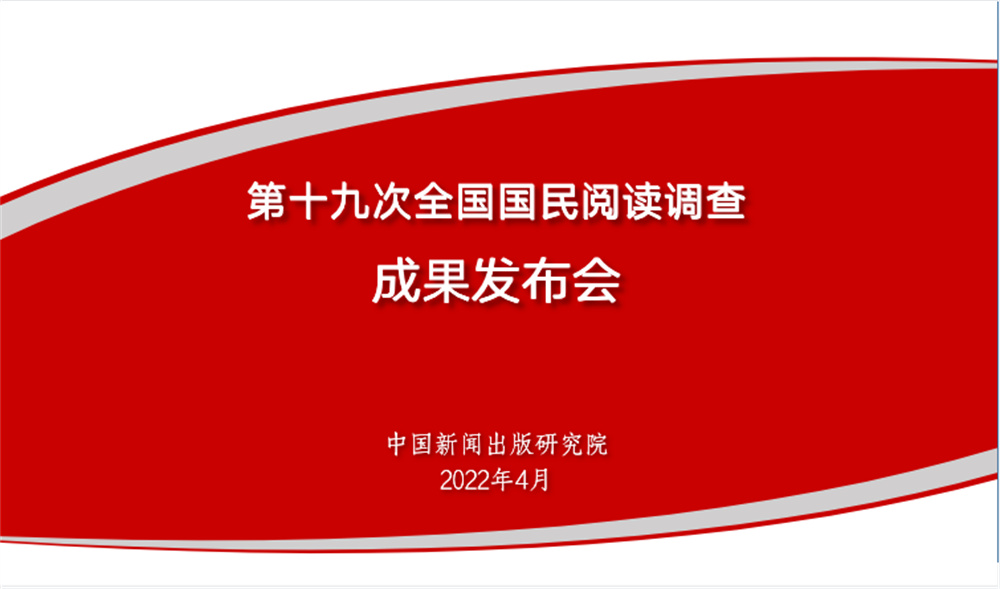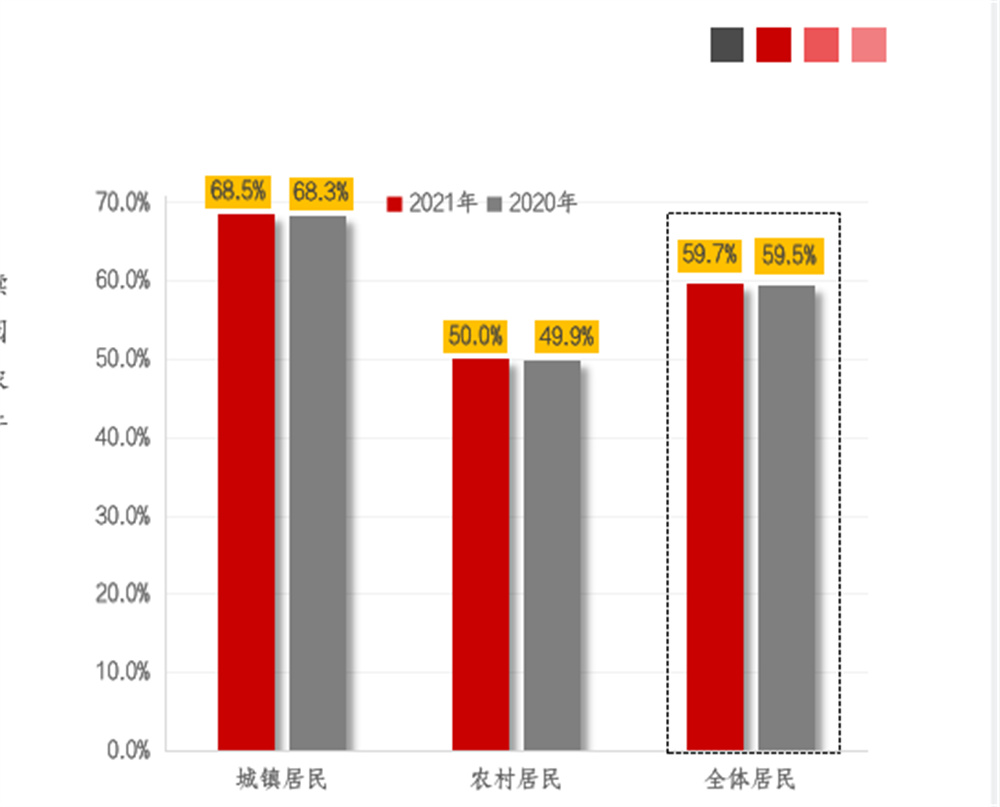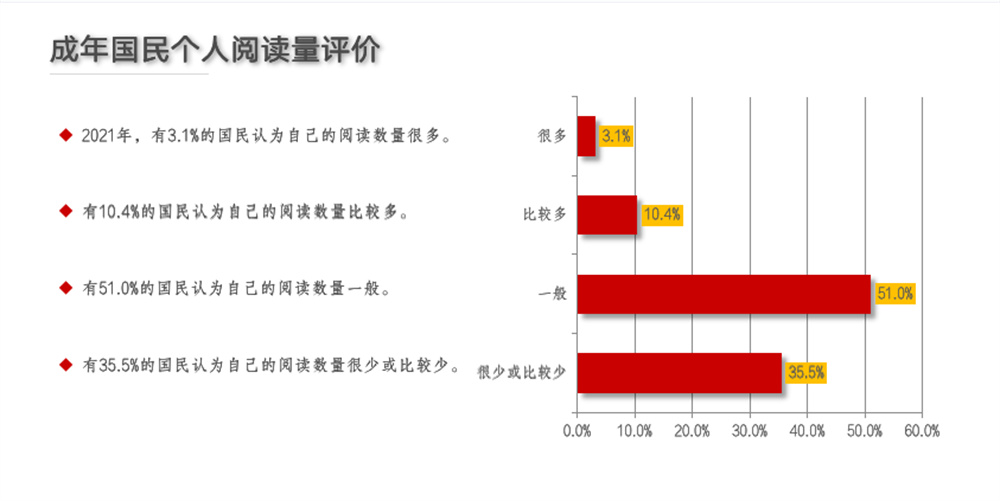
Since 1999, the national reading survey organized by the China Academy of Press and Publication has been carried out continuously for nineteen times. The 19th National National Reading Survey will be launched in August 2021, and data processing, data weighting and data analysis will be carried out from January 2022 to April 2022. This survey continues to use four sets of questionnaires to investigate the population of all age groups. Three different sets of questionnaires were used to interview the three age groups of minors (0-8 years old, 9-13 years old, 14-17 years old). The effective sample size of this survey was 42,456. After the samples were recovered, SPSS sociological statistical software was used for analysis.  During the "World Book Day" in 2022, the 19th National National Reading Survey Report was officially released, and the report also reflected the following trends.
During the "World Book Day" in 2022, the 19th National National Reading Survey Report was officially released, and the report also reflected the following trends.
77.4% of adult citizens have read mobile phone
In 2021, the reading rate of adult nationals in my country is 59.7%, an increase of 0.2 percentage points from 59.5% in 2020; the reading rate of newspapers is 24.6%, a decrease of 0.9 percentage points from 25.5% in 2020; the reading rate of periodicals is 18.4%, Compared with 18.7% in 2020, the contact rate was 79.6%, an increase of 0.2 percentage points from 79.4% in 2020. . An investigation of the book reading rate of urban and rural adult residents in my country in 2021 found that the book reading rate of urban residents in my country was 68.5%, higher than 68.3% in 2020; the book reading rate of rural residents was 50.0%, higher than 49.9% in 2020 . Further analysis of the contact situation of various digital reading carriers found that in 2021, 77.4% of adult citizens have read on mobile phones. 71.6% of adult citizens have read online online, and 21.7% of adult citizens have used Pads (tablets) for digital reading, which is basically the same as in 2020 (21.8%).
Further analysis of the contact situation of various digital reading carriers found that in 2021, 77.4% of adult citizens have read on mobile phones. 71.6% of adult citizens have read online online, and 21.7% of adult citizens have used Pads (tablets) for digital reading, which is basically the same as in 2020 (21.8%).
From the perspective of the population distribution characteristics of digital reading methods, more and more young and middle-aged groups have become the main body of digital reading. Specifically, among the adult digital reading contacts in my country, 92.8% are 18-59 years old, and 7.2% are 60 years old and above.
Although the per capita reading of paper books and e-books by Chinese adults in 2021 will increase compared with the previous year, the reading advantages of paper books are still obvious.
Judging from the reading volume of various publications by adult citizens, the per capita reading volume of paper books by adult citizens in my country in 2021 will be 4.76, higher than the 4.70 in 2020. The per capita e-book reading was 3.30, up from 3.29 in 2020. The per capita reading volume of paper newspapers was 15.13 issues (parts), which was lower than the 15.36 issues (parts) in 2020. The per capita reading volume of paper journals is 1.90 issues (copies), which is lower than the 1.94 issues (copies) in 2020.
In 2021, 11.9% of Chinese adult citizens will read 10 or more paper books per year, and 8.7% of them will read 10 or more e-books per year. Through the investigation of the book reading volume of adult residents in urban and rural areas in my country, it is found that in 2021, the number of paper books read by urban residents in my country will be 5.58, which is 0.04 more than the 5.54 in 2020; the number of paper books read by rural residents will be 3.76 , up from 3.75 in 2020.
Through the investigation of the book reading volume of adult residents in urban and rural areas in my country, it is found that in 2021, the number of paper books read by urban residents in my country will be 5.58, which is 0.04 more than the 5.54 in 2020; the number of paper books read by rural residents will be 3.76 , up from 3.75 in 2020.
"Video lectures" become new reading options
Judging from the reading form of adult nationals' preference, in 2021, 45.6% of adult nationals tend to "read a paper book", an increase of 2.2 percentage points from 43.4% in 2020; 30.5% of adult nationals prefer to read 8.4% of adults prefer to "read on e-readers"; 6.6% of adults prefer to "read online"; 7.4% of adults prefer to "listen to books" "; 1.5% of adult citizens prefer "video lectures".
Judging from the feedback of adult citizens on the changes in the reading volume of personal paper content and digital content, compared with the previous year, 12.2% of the citizens said that they "increased the reading of digital content" in 2021, but 8.9% of the citizens said 2021 "reduced the reading of digital content"; 11.6% of citizens said that "increased reading of paper content" in 2021, but 10.4% said that "reading of paper content" in 2021; also 50.1% of the nationals believe that there will be no change in personal reading in 2021.
Judging from the adult nationals' evaluation of their overall reading situation, 28.2% of the nationals are satisfied (very satisfied or somewhat satisfied); 16.6% of the nationals are dissatisfied (somewhat dissatisfied or very dissatisfied); another 41.1% of the nationals expressed in general. Adult reading time increased by more than one minute over the previous year
Adult reading time increased by more than one minute over the previous year
Among traditional paper media, in 2021, the per capita reading time of Chinese adults will be the longest, at 21.05 minutes, an increase of 1.01 minutes from 20.04 minutes in 2020; the per capita reading time per day will be 5.22 minutes, less than 5.71 minutes in 2020. ; The average daily reading time of journals is 2.96 minutes, down from 3.25 minutes in 2020.
Among digital media, adults have the longest daily contact with mobile phones per capita. In 2021, the per capita daily mobile phone contact time of Chinese adults will be 101.12 minutes, an increase of 0.37 minutes from 100.75 minutes in 2020; the per capita daily Internet contact time will be 68.42 minutes, an increase of 0.6 minutes from 67.82 minutes in 2020; the per capita daily e-reader The reading time was 11.78 minutes, an increase of 0.34 minutes from 11.44 minutes in 2020; the average daily contact time with Pads (tablets) was 9.82 minutes, an increase of 0.09 minutes from 9.73 minutes in 2020.
The survey of adult nationals' listening habits found that in 2021, more than 30% (32.7%) of adult nationals in my country have the habit of listening to books, which is 1.1 percentage points higher than the average level in 2020 (31.6%).
A survey of Chinese adult nationals listening to books found that the proportion of nationals who chose the "mobile audio app platform" to listen to books was relatively high, at 17.9%; 11.2% chose to listen to books through "WeChat Official Accounts or Mini Programs"; 10.8 % of people choose to listen to books through "smart speakers"; 8.9% and 5.7% choose to listen to books through "radio" and "audio readers or voice reading machines" respectively. Judging from the use of various public reading service facilities, in 2021, among urban adult residents in my country, 14.5% have used public libraries; 10.5% have used community reading rooms/community bookstores/urban study rooms; 10.1% have used the newspaper column. Among the urban adult residents who have used the above public reading service facilities, the public library has the highest use satisfaction, at 77.1%; the community reading room/community bookstore/urban study has a use satisfaction of 70.6%; the newspaper column has the highest use satisfaction was 62.3%.
Judging from the use of various public reading service facilities, in 2021, among urban adult residents in my country, 14.5% have used public libraries; 10.5% have used community reading rooms/community bookstores/urban study rooms; 10.1% have used the newspaper column. Among the urban adult residents who have used the above public reading service facilities, the public library has the highest use satisfaction, at 77.1%; the community reading room/community bookstore/urban study has a use satisfaction of 70.6%; the newspaper column has the highest use satisfaction was 62.3%.
Minors are reading better, and the average daily reading time has increased
Judging from the book reading rate of minors, the reading rate of children aged 0-8 will be 72.1% in 2021, an increase of 0.7 percentage points from 71.4% in 2020; the reading rate of children aged 9-13 will be 99.1%. This is an increase of 0.4 percentage points from 98.7% in 2020; the reading rate of young people aged 14-17 is 90.1%, an increase of 0.4 percentage points from 89.7% in 2020. Based on the above data, the reading rate of books for minors aged 0-17 in my country will be 83.9% in 2021, an increase of 0.5 percentage points from 83.4% in 2020.
The analysis of the reading volume of books by minors found that the per capita reading volume of extracurricular books for teenagers aged 14-17 in my country is the largest in 2021, at 13.10, which is higher than 13.07 in 2020; the per capita reading volume of children aged 0-8 is 10.33 This is higher than the 10.02 books in 2020; the per capita reading volume of children aged 9-13 is 10.21 books, higher than the 9.63 books in 2020. Based on the above data, the per capita reading volume of minors aged 0-17 in my country in 2021 will be 10.93, an increase of 0.22 from 10.71 in 2020.
In terms of reading time of minors, the average daily reading time of children aged 9-13 is 25.48 minutes, an increase of 2.22 minutes from 23.26 minutes in 2020; the average reading time of children aged 14-17 is 51.90 minutes per day, An increase of 0.09 minutes from 51.81 minutes in 2020.
Image 6
In 2021, the contact rate of digital reading methods for minors aged 0-17 in my country will be 72.5%. Specifically, the contact rate of digital reading methods for children aged 0-8 was 69.2%, the contact rate for children aged 9-13 was 76.4%, and the contact rate for children aged 14-17 was 74.8%.
In 2021, the listening rate of minors aged 0-17 in my country will be 32.7%. Specifically, the listening rate of children aged 0-8 was 33.7%, the listening rate of children aged 9-13 was 31.4%, and the listening rate of children aged 14-17 was 32.6%.
An analysis of the early reading behavior of parents and children found that in 2021, 73.2% of families with children aged 0-8 in my country usually have the habit of reading with their children, an increase of 1.5 percentage points from 71.7% in 2020. In addition, in families with children aged 0-8 who have reading behaviors, parents spend an average of 26.14 minutes reading with their children every day, an increase of 0.33 minutes from 25.81 minutes in 2020.
According to comprehensive calculations, the national reading index in 2021 will be 70.62 points, an increase of 0.17 points from 70.45 points in 2020. Among them, the personal reading index was 73.09 points, an increase of 0.04 points from 73.05 points in 2020; the public reading service index was 67.66 points, an increase of 0.03 points from 67.63 points in 2020.
 During the "World Book Day" in 2022, the 19th National National Reading Survey Report was officially released, and the report also reflected the following trends.
During the "World Book Day" in 2022, the 19th National National Reading Survey Report was officially released, and the report also reflected the following trends.77.4% of adult citizens have read mobile phone
In 2021, the reading rate of adult nationals in my country is 59.7%, an increase of 0.2 percentage points from 59.5% in 2020; the reading rate of newspapers is 24.6%, a decrease of 0.9 percentage points from 25.5% in 2020; the reading rate of periodicals is 18.4%, Compared with 18.7% in 2020, the contact rate was 79.6%, an increase of 0.2 percentage points from 79.4% in 2020. . An investigation of the book reading rate of urban and rural adult residents in my country in 2021 found that the book reading rate of urban residents in my country was 68.5%, higher than 68.3% in 2020; the book reading rate of rural residents was 50.0%, higher than 49.9% in 2020 .
 Further analysis of the contact situation of various digital reading carriers found that in 2021, 77.4% of adult citizens have read on mobile phones. 71.6% of adult citizens have read online online, and 21.7% of adult citizens have used Pads (tablets) for digital reading, which is basically the same as in 2020 (21.8%).
Further analysis of the contact situation of various digital reading carriers found that in 2021, 77.4% of adult citizens have read on mobile phones. 71.6% of adult citizens have read online online, and 21.7% of adult citizens have used Pads (tablets) for digital reading, which is basically the same as in 2020 (21.8%).From the perspective of the population distribution characteristics of digital reading methods, more and more young and middle-aged groups have become the main body of digital reading. Specifically, among the adult digital reading contacts in my country, 92.8% are 18-59 years old, and 7.2% are 60 years old and above.
Although the per capita reading of paper books and e-books by Chinese adults in 2021 will increase compared with the previous year, the reading advantages of paper books are still obvious.
Judging from the reading volume of various publications by adult citizens, the per capita reading volume of paper books by adult citizens in my country in 2021 will be 4.76, higher than the 4.70 in 2020. The per capita e-book reading was 3.30, up from 3.29 in 2020. The per capita reading volume of paper newspapers was 15.13 issues (parts), which was lower than the 15.36 issues (parts) in 2020. The per capita reading volume of paper journals is 1.90 issues (copies), which is lower than the 1.94 issues (copies) in 2020.
In 2021, 11.9% of Chinese adult citizens will read 10 or more paper books per year, and 8.7% of them will read 10 or more e-books per year.
 Through the investigation of the book reading volume of adult residents in urban and rural areas in my country, it is found that in 2021, the number of paper books read by urban residents in my country will be 5.58, which is 0.04 more than the 5.54 in 2020; the number of paper books read by rural residents will be 3.76 , up from 3.75 in 2020.
Through the investigation of the book reading volume of adult residents in urban and rural areas in my country, it is found that in 2021, the number of paper books read by urban residents in my country will be 5.58, which is 0.04 more than the 5.54 in 2020; the number of paper books read by rural residents will be 3.76 , up from 3.75 in 2020."Video lectures" become new reading options
Judging from the reading form of adult nationals' preference, in 2021, 45.6% of adult nationals tend to "read a paper book", an increase of 2.2 percentage points from 43.4% in 2020; 30.5% of adult nationals prefer to read 8.4% of adults prefer to "read on e-readers"; 6.6% of adults prefer to "read online"; 7.4% of adults prefer to "listen to books" "; 1.5% of adult citizens prefer "video lectures".
Judging from the feedback of adult citizens on the changes in the reading volume of personal paper content and digital content, compared with the previous year, 12.2% of the citizens said that they "increased the reading of digital content" in 2021, but 8.9% of the citizens said 2021 "reduced the reading of digital content"; 11.6% of citizens said that "increased reading of paper content" in 2021, but 10.4% said that "reading of paper content" in 2021; also 50.1% of the nationals believe that there will be no change in personal reading in 2021.
Judging from the adult nationals' evaluation of their overall reading situation, 28.2% of the nationals are satisfied (very satisfied or somewhat satisfied); 16.6% of the nationals are dissatisfied (somewhat dissatisfied or very dissatisfied); another 41.1% of the nationals expressed in general.
 Adult reading time increased by more than one minute over the previous year
Adult reading time increased by more than one minute over the previous yearAmong traditional paper media, in 2021, the per capita reading time of Chinese adults will be the longest, at 21.05 minutes, an increase of 1.01 minutes from 20.04 minutes in 2020; the per capita reading time per day will be 5.22 minutes, less than 5.71 minutes in 2020. ; The average daily reading time of journals is 2.96 minutes, down from 3.25 minutes in 2020.
Among digital media, adults have the longest daily contact with mobile phones per capita. In 2021, the per capita daily mobile phone contact time of Chinese adults will be 101.12 minutes, an increase of 0.37 minutes from 100.75 minutes in 2020; the per capita daily Internet contact time will be 68.42 minutes, an increase of 0.6 minutes from 67.82 minutes in 2020; the per capita daily e-reader The reading time was 11.78 minutes, an increase of 0.34 minutes from 11.44 minutes in 2020; the average daily contact time with Pads (tablets) was 9.82 minutes, an increase of 0.09 minutes from 9.73 minutes in 2020.
The survey of adult nationals' listening habits found that in 2021, more than 30% (32.7%) of adult nationals in my country have the habit of listening to books, which is 1.1 percentage points higher than the average level in 2020 (31.6%).
A survey of Chinese adult nationals listening to books found that the proportion of nationals who chose the "mobile audio app platform" to listen to books was relatively high, at 17.9%; 11.2% chose to listen to books through "WeChat Official Accounts or Mini Programs"; 10.8 % of people choose to listen to books through "smart speakers"; 8.9% and 5.7% choose to listen to books through "radio" and "audio readers or voice reading machines" respectively.
 Judging from the use of various public reading service facilities, in 2021, among urban adult residents in my country, 14.5% have used public libraries; 10.5% have used community reading rooms/community bookstores/urban study rooms; 10.1% have used the newspaper column. Among the urban adult residents who have used the above public reading service facilities, the public library has the highest use satisfaction, at 77.1%; the community reading room/community bookstore/urban study has a use satisfaction of 70.6%; the newspaper column has the highest use satisfaction was 62.3%.
Judging from the use of various public reading service facilities, in 2021, among urban adult residents in my country, 14.5% have used public libraries; 10.5% have used community reading rooms/community bookstores/urban study rooms; 10.1% have used the newspaper column. Among the urban adult residents who have used the above public reading service facilities, the public library has the highest use satisfaction, at 77.1%; the community reading room/community bookstore/urban study has a use satisfaction of 70.6%; the newspaper column has the highest use satisfaction was 62.3%.Minors are reading better, and the average daily reading time has increased
Judging from the book reading rate of minors, the reading rate of children aged 0-8 will be 72.1% in 2021, an increase of 0.7 percentage points from 71.4% in 2020; the reading rate of children aged 9-13 will be 99.1%. This is an increase of 0.4 percentage points from 98.7% in 2020; the reading rate of young people aged 14-17 is 90.1%, an increase of 0.4 percentage points from 89.7% in 2020. Based on the above data, the reading rate of books for minors aged 0-17 in my country will be 83.9% in 2021, an increase of 0.5 percentage points from 83.4% in 2020.
The analysis of the reading volume of books by minors found that the per capita reading volume of extracurricular books for teenagers aged 14-17 in my country is the largest in 2021, at 13.10, which is higher than 13.07 in 2020; the per capita reading volume of children aged 0-8 is 10.33 This is higher than the 10.02 books in 2020; the per capita reading volume of children aged 9-13 is 10.21 books, higher than the 9.63 books in 2020. Based on the above data, the per capita reading volume of minors aged 0-17 in my country in 2021 will be 10.93, an increase of 0.22 from 10.71 in 2020.
In terms of reading time of minors, the average daily reading time of children aged 9-13 is 25.48 minutes, an increase of 2.22 minutes from 23.26 minutes in 2020; the average reading time of children aged 14-17 is 51.90 minutes per day, An increase of 0.09 minutes from 51.81 minutes in 2020.
Image 6
In 2021, the contact rate of digital reading methods for minors aged 0-17 in my country will be 72.5%. Specifically, the contact rate of digital reading methods for children aged 0-8 was 69.2%, the contact rate for children aged 9-13 was 76.4%, and the contact rate for children aged 14-17 was 74.8%.
In 2021, the listening rate of minors aged 0-17 in my country will be 32.7%. Specifically, the listening rate of children aged 0-8 was 33.7%, the listening rate of children aged 9-13 was 31.4%, and the listening rate of children aged 14-17 was 32.6%.
An analysis of the early reading behavior of parents and children found that in 2021, 73.2% of families with children aged 0-8 in my country usually have the habit of reading with their children, an increase of 1.5 percentage points from 71.7% in 2020. In addition, in families with children aged 0-8 who have reading behaviors, parents spend an average of 26.14 minutes reading with their children every day, an increase of 0.33 minutes from 25.81 minutes in 2020.
According to comprehensive calculations, the national reading index in 2021 will be 70.62 points, an increase of 0.17 points from 70.45 points in 2020. Among them, the personal reading index was 73.09 points, an increase of 0.04 points from 73.05 points in 2020; the public reading service index was 67.66 points, an increase of 0.03 points from 67.63 points in 2020.
Related Posts